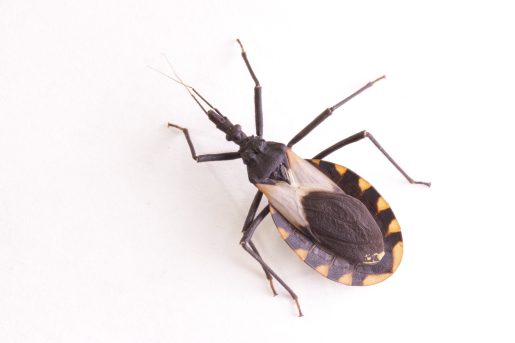Silent but Deadly: Chagas Disease and the Rise of A Tropical Illness in the RGV
This is the second of three posts from participants in Baylor College of Medicine’s National School of Tropical Medicine Summer Institute program. View the first and third post.
 When we think of deadly tropical diseases, most of us think of infections that impact people living in far-off locations in other countries. Rarely do we consider the possibility that tropical diseases are quietly spreading in Texas. But one of these infections is already here, and it doesn’t need a passport. It rides on six legs, hides in the shadows, and brings a silent but sometimes deadly threat: Chagas disease.
When we think of deadly tropical diseases, most of us think of infections that impact people living in far-off locations in other countries. Rarely do we consider the possibility that tropical diseases are quietly spreading in Texas. But one of these infections is already here, and it doesn’t need a passport. It rides on six legs, hides in the shadows, and brings a silent but sometimes deadly threat: Chagas disease.
Chagas disease, or American Trypanosomiasis, is caused by the parasite Trypanosoma cruzi. It is primarily transmitted to humans by triatomine species, commonly known as the kissing bug. These insects bite humans around the mouth or eyes while the person is sleeping, hence their nickname. After feeding, kissing bugs often defecate near the bite wound. The parasite, which lives in the feces, enters the human body through the skin at the site of the bite or through the mucosal membranes of the eyes when the person rubs or scratches the area after the bite. Beyond insect bites, Chagas disease can also spread through other means, including blood donation (blood banks in the U.S. currently screen all blood donations for T. cruzi), organ transplants, maternal transmission during pregnancy or childbirth and the consumption of contaminated food or beverages. Once a person is infected, the parasite can lie dormant for years, making early diagnosis difficult.
An estimated 300,000 people with Chagas disease are living in the U.S., the majority of whom are considered imported cases. While the disease has long been associated with rural areas of South and Central America, it is now a growing public health concern in the Rio Grande Valley (RGV) in south Texas. The statistics show that approximately 93% of kissing bugs collected in Hidalgo County have tested positive for T. cruzi. This finding suggests that Chagas disease is no longer just an imported disease; it is now locally acquired and can lead to significant morbidity and mortality.
The Silent Progression of Chagas Disease
Chagas disease progresses in two phases. The acute phase occurs shortly after infection. Most individuals have no symptoms or mild ones, which may include fever, fatigue, body aches, rash or swelling near the site of infection, known as a chagoma. Because these symptoms are non-specific and often resemble viral illness, they are easily overlooked, and in many cases, individuals never even realize they’ve been infected.
The chronic phase is typically asymptomatic for decades. However, approximately 30% of infected individuals will develop long-term complications, including end-organ damage to the heart or gastrointestinal tract. These clinical manifestations include irregular heartbeat, enlarged heart (cardiomyopathy), congestive heart failure or life-threatening digestive problems such as an enlarged esophagus or colon. In some cases, the first noticeable symptom of Chagas disease is sudden cardiac death in individuals who were never diagnosed.
Why the Rio Grande Valley is at Risk
What makes the RGV particularly vulnerable? First, the climate. The region’s warm, humid weather supports large populations of kissing bugs. Second, many homes in colonias and low-income neighborhoods have structural issues, such as cracks in the walls or gaps in the roofing, that make it easy for bugs to enter. Third, the area experiences frequent movement between Texas and Mexico, where Chagas is more common, increasing the chances of both human and animal exposure. Unfortunately, awareness among healthcare providers in the U.S. remains low. Screening for Chagas disease is not typically included in routine healthcare visits unless the provider has had previous experience with Chagas disease or has had advanced training in tropical medicine. Finally, access to healthcare in the RGV is limited and many families face barriers such as a lack of insurance, transportation challenges or language differences. These issues contribute to delayed diagnosis and treatment, making it harder to prevent the disease from progressing. As a result, many infections go undiagnosed and people suffer from avoidable complications of Chagas disease.
Diagnosing Chagas disease is complicated, requiring at least two independent serologic tests to confirm diagnosis. However, the earlier the disease is detected, the better the chances of preventing serious health consequences. Screening for Chagas disease is recommended for all people who were born in or have spent more than six months living in Mexico, Central America or South America, have a first-degree family member with Chagas disease, and all individuals donating blood or organs. Additionally, screening is recommended for people with exposure to kissing bugs in areas of the U.S. where there is evidence of T. cruzi-positive kissing bugs. However, there are no specific screening recommendations for people living in the RGV along the U.S.-Mexico border.
Treatment is available and can be effective, particularly when given early. The two FDA-approved medications for Chagas disease are Benznidazole and Nifurtimox. These drugs are most effective during the acute phase but also may help slow the progression of chronic disease and reduce the risk of long-term complications. However, access to these medications remains limited due to a lack of knowledgeable healthcare providers and limited drug availability in pharmacies, contributing to gaps in care.
Protecting Communities Through Prevention
So how can we prevent Chagas disease in our RGV community? A combination of personal and public health measures is essential. Individuals can take steps to reduce the chances of kissing bug exposure, such as sealing cracks and gaps in walls, installing screens on windows, using bed nets and keeping outdoor lights to a minimum at night (since light attracts bugs). Removing brush, woodpiles and clutter from around the home also helps reduce hiding spots for the kissing bugs.
Education is another critical tool. Communities need to be aware of the signs of kissing bugs and know how to collect and report them to public health authorities safely. Public health departments, schools and local clinics can play a significant role in providing this information, especially in underserved areas in the RGV. Ongoing epidemiologic research also is essential to monitor the distribution of kissing bugs, their transmission patterns and changes in infection rates in the South Texas region.
A One Health approach, which recognizes the connection between human, animal and environmental health, is key to stopping the spread of Chagas disease. Kissing bugs feed on a variety of wild and domestic animals, which often serve as reservoirs for T. cruzi. Reducing the overlap between human and animal habitats and understanding insect behavior are all important pieces of the prevention puzzle.
As climate change reshapes insect habitats and global travel increases, diseases once confined to historically tropical regions are spreading into new areas. Chagas disease is no longer a distant, foreign threat; it’s here and it’s real. Texans, particularly those in the RGV, need to be informed and protected.
By expanding testing programs, improving healthcare access, raising public awareness, and supporting research, we can stop this disease from silently taking hold in South Texas.
By Emiliano Lopez




I live in Livingston Texas. There are tons of Love bugs…kissing bugs all over my deck and neighbors have them too. Are they the same ones the article speaks about.